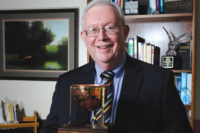The thing about the famous Goetze Caramel Creams and Cow Tales is that they are actually based on a mistake — an imperfect caramel recipe.
“They sort of screwed up how to make caramel,” explains Mitchell Goetze, ceo of Goetze’s Candy Co. “And the caramel we make, which I think makes it unique, isn’t as sweet as a classic caramel that people know. So that’s where this fondant type center came into play, it was to sweeten the caramel.”
Goetze, who recently took home Candy Industry’s 73rd Kettle Award, knows firsthand how successful that “imperfect caramel recipe” has been, though. And as the fifth generation to run the family business, he understands his place in history.
It’s a place he has never taken for granted — something his own grandfather made sure of when he was still young.
At-A-Glance: Goetze's Candy Co.
Headquarters: Baltimore, Maryland, 175,000 sq. ft.
Founded: 1895
Employees: 95
Brands: Caramel Creams and Cow Tales
Management Team: Mitchell Goetze, ceo; Todd Goetze, president and coo; and David Long, CFO.
Mitchell worked at the factory during the summers when he was in high school and when he finished on the last day of the summer after his senior year, they held a lunch to celebrate.
“And at the end of lunch, my grandfather — who had big hands, cufflinks, a big ring, sort of that classic patriarch look — he leaned into the table, he looked at me, he pointed his finger at me, and said, ‘Just because your name is on the front of the building doesn’t mean I owe you anything,’” Goetze recalls. “And I kind of sat back and I thought to myself at the time, ‘What the hell did I do wrong?’ But really what he was saying to me was, ‘Your name may be on the building, but there’s a lot of people that have worked a lot of hard hours to build it to this point,’ and there was a lot of tough love with my grandfather and certainly my dad and my uncle. Looking back on those years I definitely think it created who my brother [Todd Goetze, president and coo] and I are.”
Goetze’s sweet history
The story really starts more than 100 years ago. Back before his grandfather was even around.
That’s when August Goetze, Mitchell’s great-great-great grandfather, bought Baltimore Chewing Gum Co. with his son, William, in 1895. August was working as an engraver, producing many of the printing plates for the gum company and learned that the business wasn’t doing so well, so August made an offer to buy the candy company with his son.
It was a business decision that would impact the Goetze family for generations.
In 1929, the company moved to its current location, which today sits in the heart of Baltimore.
“Back then this was considered the country,” Mitchell says.
Now, the factory is literally landlocked. However, the family just completed the purchase of the building next door (building to the right in the ariel photo on page 23). and plans to tear it down and rebuild an expansion, adding on about 40,000-50,000 sq. ft. to their current 100,000-sq.-ft. factory. They also have a 75,000-sq.-ft. warehouse facility three miles away.
But back in the early part of the last century the company was much smaller — just 24,000 sq. ft. when they first bought the building at that location — and it was focused on different things.
“We made literally everything,” Goetze says. “Nobody was really distributing coast to coast, so it was pretty typical that you shipped 300-400 miles away, and the next guy shipped 300-400 miles away and that's really what what we did.”
William's son, R. Melvin Goetze, Sr., joined the company in 1909. And the First World War led to shortage of chicle that inspired the family to develop new confections. In 1917 Melvin Sr. began making "chuees" (Caramel Creams without the center) out of the family's kitchen. Caramel Creams were developed soon after and were released the following year.
The treat was a hit.
“They really said, this is unique, it’s different, maybe this is what we should really concentrate on,” Goetze says. “And they did. In 1958 is when they incorporated as the Goetze’s Candy Co., and started exclusively making caramel.”
Eventually they were even able to trademark the candy both wrapped and unwrapped.
People are often surprised to learn that to this day Goetze only makes Caramel Creams and Cow Tales. But the strategy just makes the most sense to Mitchell.
“We want to stay really focused. We don’t want to be a $500-million company to be perfectly honest with you,” he says. “We grew up pretty humble, with just: Do what you’re good at, do it everyday, support the industry, be kind to your employees and try to carry on the tradition.”
And that’s exactly what he has done.
Today he leads the company with his brother Todd, as well as his cousin-in-law David Long, who is CFO.
Mitchell also has served on the Board of Directors of the National Confectioners Association for the past 15 years, including executive board roles, beginning with treasurer, continuing with vice chairman and culminating as chairman.
Most notably, though, Goetze served as Chairman of NCA’s Strategic Planning Committee from its inception in 2008 through 2014, which helped guide the association through an extensive reorganization (see sidebar).
And Goetze still serves as a member of the NCA’s Leadership Strategy Committee and continues giving back to help guide the industry forward. In 2017 he was awarded the Doc Reed Silver Candy Dish award in recognition of significant contributions to the marketing and selling of confectionery items.
Making the caramels
Of course Goetze knows the most important work is really in the factory. Growing up, working there during the summers, he remembers his dad telling him that they couldn’t leave until everyone else leaves.
Today the company has become the largest caramel producer in the United States, but by focusing on efficiencies and automation they are able to produce all of that by running mostly one shift, with some overflow into second.
“Some of that is a quality of life,” Mitchell says. “My brother always said, ‘People want to go home and turn out the lights and show up refreshed in the morning.’ And we want to run as much as we can in a first shift because first shifts are the most efficient, period.”
Mitchell also prides the company on maintaining 95 employees for more than 20 years while also incorporating those efficiencies and automation.
“We’ve maintained our workforce, we’ve increased output and efficiencies, we’ve made jobs easier for our people, and we’ve been able to have nice growth through automation,” he explains.
The company also focuses more on creating the most pounds of candy per sq. ft., and the most pounds of candy per employee, as opposed to just sales figures.
And when it comes to expansion and upgrades, the company has taken Mitchell’s grandfather’s approach of caution.
“We don’t borrow money from the bank,” Mitchell says. “My grandfather always said, ‘If you need to do something or buy something, you better be able to pay for it. And if you can’t pay for it, maybe you shouldn’t do it.’ It has probably hurt the speed at which we’ve grown, but I sleep pretty good at night.”
However, they are actually in the midst of a huge upgrade and expansion into the neighboring property that they just bought.
They also have recently upgraded their packaging lines.
“Our newest line is producing twice the output of the bagging lines of when I worked there,” Mitchell says. “And that’s only possible because of robotic pickers.”
Mitchell sees the next big challenge as automating their cut and twist machines.
“Because this look [of the twist wrapping on the candy] is as much our brand as is the product, and as we continue to grow, that’s going to be the next big automation project,” he says. “That’s not unique to us.”
And they are working on installing up to five robotic palletizers.
“We continue to automate only because we realize that to grow we can’t just buy and rent more space, finance machines, [and] hire more people, we’ve got to become very efficient, and frankly, we need to be better than the next guy,” Goetze says.
Most of the company’s candy making process is proprietary, but Mitchell says they make all the caramel on site, and it’s still made exactly the same way as it was when his grandfather was still there.
“We manufacture our own caramel, and it’s a unique formula that goes back to the beginning, it’s different. It has a different flavor profile. It doesn’t stick to your teeth,” Mitchell says. “And then we marry it with the center and then those ropes of product are transported to the different machines, based on if we’re making Caramel Creams or Cow Tales. So it all starts in the same place.”
However, while the two products are very similar, Mitchell says they aren’t exactly the same formula — there are slight variations between the two recipes.
Once the candy is made, they send it through various packaging lines depending on where it’s going to end up.
“[The Caramel Cream] either goes to loose twist wrap bulk product and to rebaggers and bulk stores, or it’s packaged in a variety of bag sizes, it’s put in tubs, it’s put in the classic tray pack,” Mitchell says. “If it’s a Cow Tale, it goes into the standard 1-oz. stick minis, retail boxes, or it goes to bags, tubs or bulk."
The confections are then sold in every class of trade, from the largest Walmart to the smallest candy stores and even the military. And they don’t exactly have a target market.
How Mitchell Goetze led the NCA’s strategic planning process
For Mitchell Goetze, running a successful candy company isn’t enough — he also is highly involved in the industry.
From 2008 through 2014 he served as Chairman of NCA’s Strategic Planning Committee from its inception, which helped guide the association through an extensive reorganization.
“There was an understanding that things were really changing, and they were changing quickly” Mitchell recalls. “It was after a board meeting and we had talked about, is it time to do another strategic plan? And the decision was … we really need to take a step back and understand what the future looks like.”
And then Mitchell got involved — although it wasn’t exactly his idea to sign up.
“Ross Born [of Just Born] kind of turns to me and he says, ‘I think Mitchell would be a great chair for the strategic plan.’ I looked at Ross and said, ‘Woah, woah, woah, wait a minute, this sounds like a significant project!”
But they persuaded him to take it on.
“Basically they convinced me that [I was] sort of representing this next generation,” he says. “[They said], ‘You’re the one who’s really going to be living the next 20 years, you ought to be involved in it.’”
And essentially what they worked to do with the strategic plan was define what the future of the NCA was going to looking like.
They started with what the members value proposition was, as well as who those members were. Essentially they could be divided up into five groups: Brokers and suppliers, as well as small, medium and large manufacturers.
“And each one of those membership segments had a very different reason that they saw value in a trade association,” Goetze says.
They soon realized that the NCA would need to be an advocacy, public policy- and regulatory-driven association.
“That is the one thing that all five member segments have in common and they can’t do themselves,” Goetze explains. “Because whether you’re a million-dollar company or you’re a billion-dollar company, or you’re a supplier or you’re a broker, everyone needs the protection of a bigger group.”
In the end, Goetze is happy Born volunteered him for the project.
“You wonder why we’re dedicated to industry and we show support back to NCA and different industry events, I think it’s because we really value how we got here,” he says. “We understand that there’s a lot of hard work from the Goetze family, but there’s a lot of other people and entities that have certainly contributed to our success and we don’t want to forget that.”
“What we’ve learned from marketing is you can’t just say kids between 10 and 15 love this product. While we feel like [the Caramel Cream] is more adult, kids love it,” Mitchell says. “We feel like Cow Tales are skewing younger, but a lot of adults eat them. So it’s really hard to figure out who is our core consumer. But we’ve been very lucky that it’s broad in scope and that helps us.”
Both the Caramel Creams and Cow Tales come in a variety of flavors, including: “original” vanilla, chocolate, strawberry, licorice, and caramel apple. But expanding beyond original hasn’t been easy.
“The challenge with caramel is that you’re basically burning sugar and milk and right before it tastes awful and turns black, you stop burning it. And it creates brown caramel,” Mitchell says. “The product in itself is a flavor and the end product is brown, and has an inherent flavor — unlike sugar lollipops where the base is the base. So, it’s very difficult to change a brown product to red or any other color for that matter. And it’s very difficult to take an inherent base flavor and change that flavor.”
As a result, it comes down mostly to the cream and filling that they use in the Caramel Creams and Cow Tales.
“But there are only certain flavors that marry well with caramel,” Goetze says. “It’s hard to make it a completely different product. And part of our success is concentrating on efficiencies, there’s big value in doing a couple things, doing them really well and being super efficient.”
They have recently rebranded Cow Tales with a new look and feel, including theater boxes. And they’re getting ready to do the same with Caramel Creams.
“But we want to be very careful because that’s our legacy brand and we don’t want to mess it up,” Goetze says. “And there’s some expansion coming, but we don’t want to do that at the cost of our efficiencies. Because as a mid-size company, we can’t lose sight of what’s keeping us in business just for the sake of coming out with extensions.”
Shaping the next generation
Something that’s become really important to Goetze as he has gotten older is the idea of passing on the business to the next generation.
He himself grew up in the candy business, literally attending his first candy trade show with his father when he was just 6.
“When my father and grandfather took us to trade shows and other industry events it really opened our eyes to relate our candy company and what we’re doing to this much bigger industry,” he recalls. “Yes we saw candy bars in stores, but to meet Jim Gagliarducci, who at the time was running Sunmark — and I loved Sweetarts — as a kid that was what triggers in your head, there are real people behind these brands. And that has instilled love and excitement of this being much bigger than us making caramel on 3900 E. Monument St.”
And he looks back with regret and how the industry has really changed how it treats kids, no longer allowing them at the Sweets and Snacks Expo in an effort to keep things more “professional.”
“If there’s one thing that’s upsetting to me is this feeling the children kind of got in the way,” Goetze says. “This is a professional industry but it’s deeply rooted in kids and excitement.”
The sixth generation of the Goetze family has been around the factory for years, and several of them currently are working in production, including Mitchell’s oldest brother’s children Spalding III, Emily, and Lily, as well as two of Mitchell’s three children, Ella and Cooper.
But Mitchell says the Kettle, which was handed out on the Tuesday night of the Sweets and Snacks Expo, was the first time all three of his kids were able to go to the show.
“We got home from that show and my children, when I talked to them about it, I could see the same things clicking in their heads that clicked in mine, especially my son Cooper. Goetze says. “But now he’s 17, and as an owner and father and hoping the next generation gets involved, I wish that would have happened years ago.”
And just like for Mitchell, it was a meeting with an industry icon that really impacted his children. It’s a moment that brings Mitchell to tears when he talks about it.
“When they met Herm Rowland, the Jelly Belly guy, I could tell that was the trigger,” Mitchell says. “I saw my son, I saw my daughters, I could tell that was the stuff that made Todd and I fall in love with this. And they told me so. They had the same feeling and the same story as when I met industry people, like, ‘That’s the guy behind the jelly beans?’”
Keeping a family business in the family for so long isn’t easy, and they have hit some bumps along the way. When Mitchell’s great-grandfather Melvin Sr. passed away in 1972, there was a heated dispute over who would lead the company going forward.
After that they set up a strict stockholder program, and any time new members are allowed in, all the stockholders have to approve it. Today there are just five stockholders including: Mitchell, Todd, David, Mitchell’s dad, Spaulding, as well as his uncle, Randle.
“We’re pretty proud of how we’ve been able to hold the thing together,” Goetze says. “Each generation isn’t really an owner, they’re the stewards of the company at that moment in time and certainly the purpose here is not to be a sales-driven company but to preserve it, in hopes of handing it off.”
And indeed, there’s little doubt that the sixth generation will hear a similar message to the one Mitchell heard all those years ago from his grandfather — your last name gives you responsibility, not necessarily ownership. And there’s little doubt they too will live up to the sweet challenge that comes with being a member of the Goetze family.
“I don’t want failure on my watch,” Mitchell says.
Even if he does though, he’ll likely turn it into a success — just like the previous generations did all those years ago with that “imperfect caramel recipe.”




















